[Sam Watson splits his time between Yorkshire, the Middle East and Africa, where he travels regularly in his Defender 110, a Defender 130 or a Discovery II. He’s a regular contributor to British Land Rover publications. He takes us along to Morocco in this article -ed.]
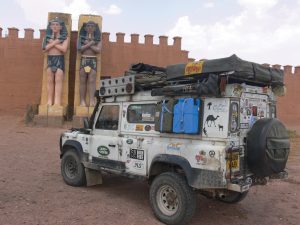 The Sahara sits in the back of the mind of many Land Rover owners — the biggest, hottest desert in the world, populated by Tuareg, Bedouin and Berber; the haunt of camel caravans, Pharoahs, sandstorms and quicksand. Myths and legends about this massive wilderness are numerous. Of course, its African location makes access awkward, especially in these days of worries about safe travel. Rover owners in Britain have it easy — for us it’s “just down the road.” Three days on the freeways of France and Spain will see you sailing across the Mediterranean aboard a ferry and into North Africa — and thence onto the dunes of the Sahara Desert.
The Sahara sits in the back of the mind of many Land Rover owners — the biggest, hottest desert in the world, populated by Tuareg, Bedouin and Berber; the haunt of camel caravans, Pharoahs, sandstorms and quicksand. Myths and legends about this massive wilderness are numerous. Of course, its African location makes access awkward, especially in these days of worries about safe travel. Rover owners in Britain have it easy — for us it’s “just down the road.” Three days on the freeways of France and Spain will see you sailing across the Mediterranean aboard a ferry and into North Africa — and thence onto the dunes of the Sahara Desert.
Baz Rowlingson and Abbie Myers, two friends who had always wanted to see the desert but couldn’t afford a commercial desert trip, enticed me to return to some bits of the Sahara that I hadn’t seen for a while. We all had a four-week window in August, so we threw kit into the back of Elsa, my long-suffering 1991 Defender 110, and headed off to the desert.
 Europe passed swiftly (if rumbling along like a tectonic event in a fully-laden diesel Defender can be called “swift”) and about four days later we pulled into the British Crown Colony of Gibraltar at the south end of Spain to take on tax-free fuel, before crossing into Africa. The local superstore on “Gib” is a branch of British grocers, “Morrisons”, and you will generally find a handful of overland Land Rovers parked up there. If their travels will take them south to Africa, it’s the last chance to stock up on proper beer, decent cheese and food from home. If, on the other hand, they’ve just come back from a trip south then the crews will be in the store salivating over anything that makes a worthwhile change from goat. Sure enough, we stocked up.
Europe passed swiftly (if rumbling along like a tectonic event in a fully-laden diesel Defender can be called “swift”) and about four days later we pulled into the British Crown Colony of Gibraltar at the south end of Spain to take on tax-free fuel, before crossing into Africa. The local superstore on “Gib” is a branch of British grocers, “Morrisons”, and you will generally find a handful of overland Land Rovers parked up there. If their travels will take them south to Africa, it’s the last chance to stock up on proper beer, decent cheese and food from home. If, on the other hand, they’ve just come back from a trip south then the crews will be in the store salivating over anything that makes a worthwhile change from goat. Sure enough, we stocked up.
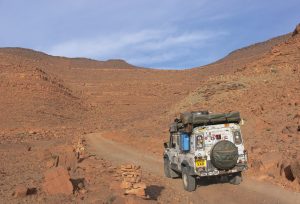 The fast, efficient ferry from neighbouring Spain to Morocco made landfall in Tangiers quickly. On clearing Customs at the docks a line of militiamen with Saddam moustaches and AK-74s confronted us. One of them beckoned us so I drove over to him and opened the window. His moustache, followed by the head, erupted into the cab. “Welcome in Tangiers!” he bellowed. “You have hashish, or automatic weapons??” Er…. no… nooo….. we shook our heads. “Would you like some?!” roared the head. Cue glassy, blank goggle stares and fixed grins — polite British apologies. I’m sorry, we do not want any drugs/firearms/carpets. We drove on.
The fast, efficient ferry from neighbouring Spain to Morocco made landfall in Tangiers quickly. On clearing Customs at the docks a line of militiamen with Saddam moustaches and AK-74s confronted us. One of them beckoned us so I drove over to him and opened the window. His moustache, followed by the head, erupted into the cab. “Welcome in Tangiers!” he bellowed. “You have hashish, or automatic weapons??” Er…. no… nooo….. we shook our heads. “Would you like some?!” roared the head. Cue glassy, blank goggle stares and fixed grins — polite British apologies. I’m sorry, we do not want any drugs/firearms/carpets. We drove on.
Morocco benefits these days from a network of fast freeways built by European Union money, and so we made good time driving south to the medieval town of Meknes, whose centre is coddled in huge mudbrick walls like something out of Star Wars. Staying overnight there, the road then took us south to Marrakesh, then through the rugged Atlas mountains.
As you travel through the winding narrow mountain passes that slice through the Atlas range like knifecuts, you go by all sorts of oddities. Kasbahs, fortified old towns, perch like Game of Thrones film sets (actually one of them is a Game of Thrones film set) over narrow, dusty canyons. In one I paused and Abbie started snapping away pics of the lush green crop growing in the valley around us. Very quickly however local Berber tribesmen appeared and made threatening gestures at us and our cameras. Abbie looked solemn when I suggested we’d better move on —”Do they think the cameras will steal their souls?” I paused, looking hard at the crops. “No. It’s marijuana. They think we’re cops.” Exit, stage left, in a cloud of dust.
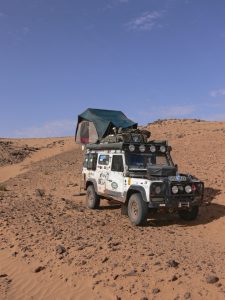
Ouazarzate was the next port of call, and on the way, in the nearby desert, we saw a huge film studio with a life-size Egyptian temple built out of fiberglass, a relic of some recent French blockbuster filmed out here. No ruin, this, but fully-painted and intact, as if the Pharoah had just nipped out for a beer. Predictable and rather surreal photos followed. The desert starts here, too, as the mountains and their greenery drop away and open up into blasted, sun-beaten plains of gravel and rock. I aimed the Rover for Zagora, an oasis town in the Camping Sindibad where there was a good campsite that we could use to give the 25-year-old truck a quick once-over before heading out into the Sahara.
Sure enough, as evening fell I pulled into Camping Sindibad and we set up a roof tent and two ground tents, and got a fire going. Scotch made an appearance, as after a while did a British-registered Nissan Navara 4×4 pickup with a demountable camper body. We exchanged waves, and the couple inside drove to the other side of the (empty) site — ah, British reserve. Shortly afterwards I wandered over with half a mug of Scotch to greet them. Mike and Carole Smith relived their 25th wedding anniversary — they had met on an overland truck trip out this way — with this trip. They eyed the kitted-up Defender apprehensively, as she squatted purposefully under the palm trees opposite in a cloud of tents, jerrycans, campfire smoke and exciting big metal boxes. Were we, by any chance, going out into the desert? “Yes,” I answered, “That’s the plan.” Could they come along? I peered at the Navara. Reasonable clearance, decent engine and transmission, all-terrain tires — yeah, why not?
I brought over two jerrycans of diesel and two of water as well as a spare set of sand ladders (desert recovery aids like Maxtrax) to lend to our new friends (and reassure the Nissan, which had started to gibber quietly to itself) and, the next morning, vehicle checks performed, off we went. Destination One was the Tuareg village of Tagounite, a little further south, where we would leave tarmac and head northeast along the ill-defined Moroccan-Algerian border and through a pretty and atmospheric two-to-three day drive through the open Sahara. On reaching Tagounite I gave the Nissan crew a quick briefing. It was August, the hottest time to travel through the Sahara, and temperatures were easily over 110 degrees for most of the day. I cautioned Mike and Carole — “Don’t use your air conditioning, it will dehydrate you. If you do use it, drink at least a pint every hour.” Sober agreement. The land became the anvil of the sun that day — brutally hot and dry, even now, early in the morning.

As we rolled out the going quickly became very rocky. On the tarmac the Nissan had been the fastest vehicle, cruising along happily a good 10 mph faster than the older, heavier Defender, but once into the rough stuff the Defender reversed roles, setting the pace and the course. Towing the Nissan out became a regular occurrence, although, to be fair, Mike and Carole had never tackled desert sands. Rocks fell away as the miles went on, and we skirted the edge of the Merzouga Sand Sea, a huge area of giant dunes. True to form, and even though we’d aired their tires down to 15 psi, the Nissan kept sticking.
I drew us in after about four hours of driving. The sun at its highest beat down on us; I trundled over to the Nissan to ask how they were doing. Alarm gripped me as neither Mike nor Carole could speak clearly. Confused, Mike tried to get out of the truck, stumbled, and fell into my amazed grip. Dehydration, and bad, too. They had been running their aircon and not drinking, and the result was bad heatstroke. I propped Mike in his seat and retrived a water bottle from Elsa; Mike swigged it down — promptly vomiting it back up. I added rehydrant salts, with the same result, only now pink and smelling of black currant. Dehydration can kill. We had to get Mike’s core temperature down fast. Rigging a poncho as shelter between the Defender and the Nissan we got him into the shade and covered him with towels, pouring cold water from the Land Rover’s plumbed-in tanks over his head and chest to bring his temperature down, whilst urging him to sip small amounts of rehydrant. I had an intravenous drip set in the 110 but wasn’t ready to go to that stage yet… Three or four hours went by like this. Mercifully, after a while Mike started to retain fluids and his core temperature began to drop.
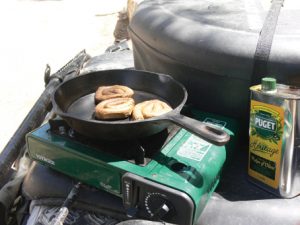
Thanking providence, we made preparation for bed. Though Carole had some symptoms of heatstroke she was able to keep dosing Mike with rehydrant throughout the night, so I shut down for the day. Sleep came easy that night.
Except… in the small hours I woke. What’s that? Traffic noise, go to sleep, said my subconscious. Traffic noise? A hundred miles out into the Sahara? I woke with a jerk and slid out of the roof tent. Two SUVs, Pajeros or Discoverys my binoculars told me, and a large truck. All with no lights. All heading our way. At 2 am? What was this? Night vision gear? They would likely drive straight into us. I called out in a low voice — Baz had heard it too and came out to join me. Fast thinking — we were hard up against the porous Algerian border — haunt of fundamentalists and gunrunners. If they were bad guys, and we put lights on, they would stop and maybe move away. If they were good guys, and we put lights on, they would stop and figure out what to do. Answer — put lights on.
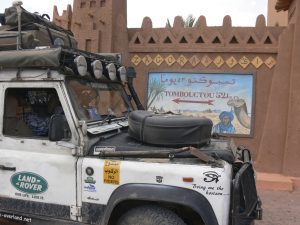
I snapped the lights of the Defender on. Consternation. The 2 SUVs and the truck slammed on brakes. Watching through binoculars I could see upwards of half a dozen guys spill out, and with them the unmistakeable shape of Kalashnikov-family rifles. Great. What was this we had stumbled into? I made hasty plans with Baz. If they come on, wake Mike and Carole, get everyone in the Defender and we go like hell.
Lots of shouting by the other vehicles. Running about. I continued to watch. After a while the rushing about and yelling died down. The trucks started up again, made a ninety-degree turn right and carried on, heading straight for the Algerian border about 2 miles away. Long outlet of held breath. Who were they? Were they really going? They were heading for the supposedly-closed Algerian border so obviously.
Time passed. After about 20 minutes I carefully headed for where the truck and SUVs had been, for a sniff about. Nothing. Lots of footprints, but nothing. What had we avoided? Had we avoided it? It seemed so. The mystery vehicles had boxed round our position and headed into the unknown and off-limits of Algeria. Sighs of relief. I eventually bedded down again in the roof tent and oblivion came.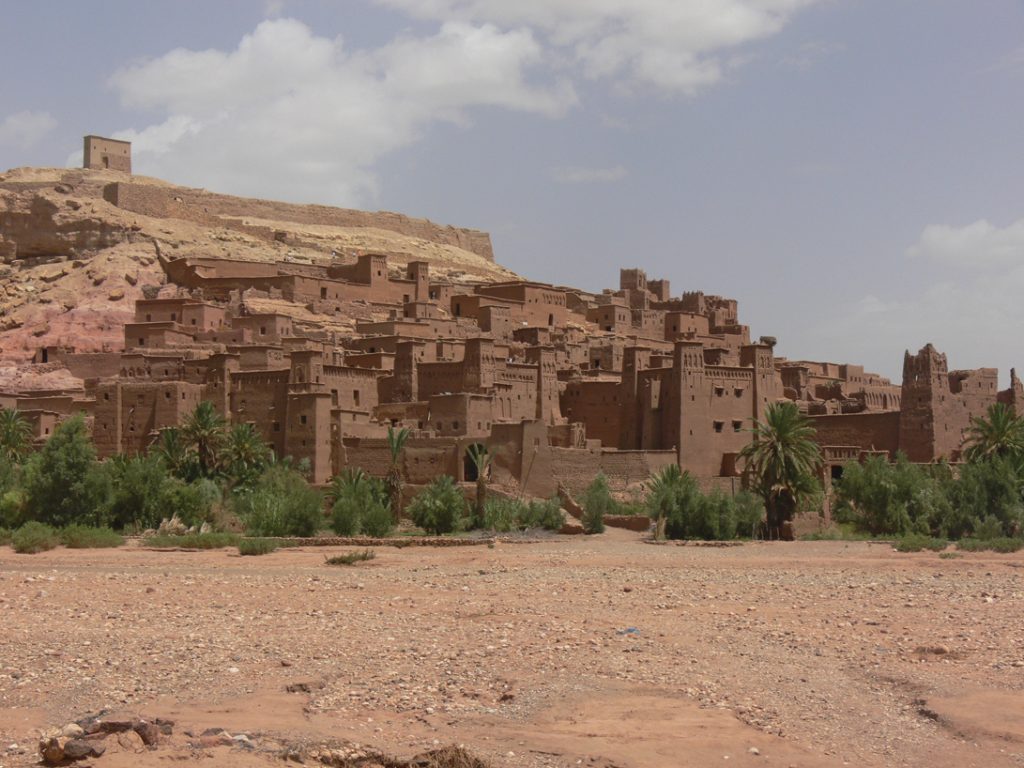
Next morning a change of plan — I re-routed us to the small Tuareg village of Tafraoute, a little off-route, where we got breakfast and welcome rehydration at the Auberge Sidi Ali. In faltering Arabic I explained our situation of the night before —they are men with beards, explained our hosts. Men with bad Islam. Not like our Islam! They take guns to Algeria — and use them too! But your cars are blue and white — they think you are police! We exchanged looks. Fundamentalists and gun-runners. Thank goodness for a white Land Rover and a blue Nissan. With plans to meet up back home in York, we parted company with Mike and Carole, who decided their Nissan wasn’t as desert-worthy as Elsa.
Headed back towards home. Toward the dunes and south to Algeria. But that is another story……
Story and Photos by Sam Wilson